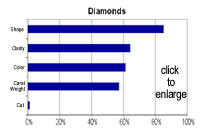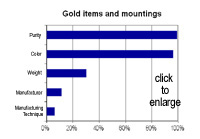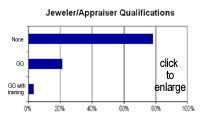What’s wrong with the current way
of preparing appraisals?
A recent survey of jewelry appraisals submitted to 21 insurance companies in 16 states found that most appraisals lacked information crucial to jewelry insurers.
In an appraisal for insurance purposes, valuation is less important than description. The appraisal should describe a piece of jewelry in sufficient detail to distinguish it from other pieces similar in appearance. A detailed appraisal can serve as a basis for valuation if the piece is lost.
Here are some of the ways the appraisals came up short:
DIAMONDS
 Most appraisals listed the shape of the stone, but the crucial "4Cs"
of diamonds were far from covered. Notice that 43% of the appraisals did
not even mention the size (carat weight) of the diamond!
Most appraisals listed the shape of the stone, but the crucial "4Cs"
of diamonds were far from covered. Notice that 43% of the appraisals did
not even mention the size (carat weight) of the diamond!
The most serious problem is that cut is left off almost all appraisals. Cut is actually the most important of the 4 Cs and can account for as much as half of the diamond'’s value.
GOLD items and mountings
 Most gave purity (for example, 14 karat), but only 30 percent gave weight
(how much gold was there, was that a hefty chain or a skimpy one?). Hardly
any mentioned the manufacturer (would you buy a car without knowing who
made it?). Manufacturing technique (hand-made, cast, dye-struck, etc.),
very rarely included, can signify great differences in price.
Most gave purity (for example, 14 karat), but only 30 percent gave weight
(how much gold was there, was that a hefty chain or a skimpy one?). Hardly
any mentioned the manufacturer (would you buy a car without knowing who
made it?). Manufacturing technique (hand-made, cast, dye-struck, etc.),
very rarely included, can signify great differences in price.
COLORED GEMSTONES
 Colored gems get their value primarily from their color, which needs to
be described in specific gemological terms for hue, value and saturation.
Yet only 48% of the appraisals listed even hue, while 32% gave tone, and
just 5% gave saturation. More than three-quarters of the appraisals did
not bother to mention the stone's size, and not one of them gave the stone's
cut.
Colored gems get their value primarily from their color, which needs to
be described in specific gemological terms for hue, value and saturation.
Yet only 48% of the appraisals listed even hue, while 32% gave tone, and
just 5% gave saturation. More than three-quarters of the appraisals did
not bother to mention the stone's size, and not one of them gave the stone's
cut.
JEWELER/APPRAISER QUALIFICATIONS
 Given the lack of hard information on the appraisals, it's not surprising
to find that most of the appraisals came from jewelry retailers with no
formal training. Only 21% came from Graduate Gemologists, even though a
GG degree can be earned from the Gemological Institute of America in 6 months.
Just 3% of those GGs had additional training in appraising.
Given the lack of hard information on the appraisals, it's not surprising
to find that most of the appraisals came from jewelry retailers with no
formal training. Only 21% came from Graduate Gemologists, even though a
GG degree can be earned from the Gemological Institute of America in 6 months.
Just 3% of those GGs had additional training in appraising.
The appraisals in this study are typical of those found throughout the insurance industry.
For years claims departments all over the country have been settling losses based on such inadequate appraisals. An adjuster is often faced with little more than a brief description and an unverified valuation—no realistic basis for pricing a replacement.
The claims department complains that underwriting should require better documentation, and agents often find their customers dissatisfied with claim settlements.
One reason the appraisal problem has been overlooked for so long is that jewelry claims are only a small part of the adjuster's load. About 500,000 jewelry claims are filed annually, with each claim averaging about $2,000. Since insurance companies do not keep detailed statistical records on their jewelry claims, some are not aware of their jewelry losses.
In a spot audit of its own claims department, one West Coast insurance company found that 27% of its jewelry claims had been miscoded because the claims were paid as general contents under a homeowner’s policy rather than as scheduled jewelry. The true loss ratio on jewelry was considerably less favorable than the company had believed.
Much of the ill will generated by unsatisfactory claim settlements could be eliminated by good appraisals.
The JISO Solution
The JISO 78/79 Jewelry Appraisal was developed specifically to meet the needs of the insurance industry:
- The form follows a standard layout, which prompts the appraiser for all necessary details on any kind of jewelry.
- The standardized layout means the agent or underwriter can immediately see that the necessary information is given. (The insurer need not know how to interpret the data, nor determine whether it is accurate; that is the appraiser’s responsibility.) The insurer’s job is to get a sufficiently detailed appraisal.
- Agents can use JISO 78/79 to explain to policyholders the importance of a detailed appraisal: that it is the basis for properly insuring their jewelry and that it also acts as the customer’s record of the quality of the jewelry. Should a loss occur, the policyholder can be sure of a settlement based on the jewelry exactly as described.
- The adjuster using JISO 78/79 appraisal can easily see the specifics of the jewelry, rather than having to wade through a narrative appraisal that may not include all necessary data. All the specific data – details missing from so many appraisals today -- are needed to accurately price a replacement.
- Insurers can expect settlement costs to go down. When details about the jewelry’s qualities are lacking, a replacement jeweler is likely to “fill in the blanks” with higher, rather than lower, qualities in order to quote a higher price. A detailed JISO appraisal allows the adjuster to comparison shop for the best replacement price.
- JISO 78/79 Jewelry Appraisal is written and signed by a Graduate Gemologist
(GG), who is also a Certified Insurance Appraiser™ (CIA). These
credentials indicate formal gemological training, at least three years
experience in buying and selling jewelry, and formal training in appraising
for insurance.
